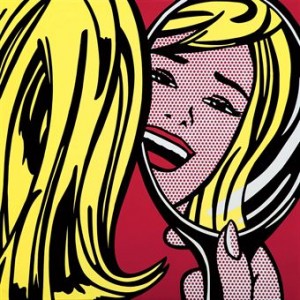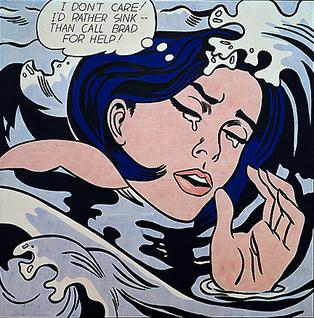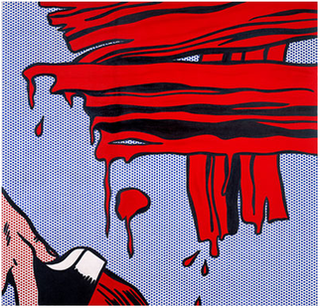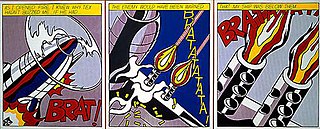| M-Maybe | |
|---|---|
 | |
| Artist | Roy Lichtenstein |
| Year | 1965 |
| Movement | Pop art |
| Dimensions | 152.4 cm× 152.4 cm(60 in× 60 in) |
| Location | Museum Ludwig, Cologne, Germany |
M-Maybe is a 1965 pop art painting by Roy Lichtenstein. It is one of his romance comics-based works.
| M-Maybe | |
|---|---|
 | |
| Artist | Roy Lichtenstein |
| Year | 1965 |
| Movement | Pop art |
| Dimensions | 152.4 cm× 152.4 cm(60 in× 60 in) |
| Location | Museum Ludwig, Cologne, Germany |
M-Maybe is a 1965 pop art painting by Roy Lichtenstein. It is one of his romance comics-based works.
Lichtenstein's first solo show at The Leo Castelli Gallery in February 1962 sold out before opening. Engagement Ring sold for $1200 and Blam sold for $1000. Prices for his work rose quickly. In 1965, German collector Peter Ludwig asked Castelli, what price Lichtenstein might accept to sell M-Maybe from his personal collection. By then, the going rate for a Lichtenstein was $6000 and Castelli estimated $12,000. Ludwig offered Lichtenstein $30,000 to purchase the work. [1]
M-Maybe depicts a blonde girl, which is typical for Lichtenstein's romance comics adaptations. As is a common theme among these works, she awaits a man in a vague but urban setting. The thought bubble reads "M–Maybe he became ill and couldn’t leave the studio". The text and her expression jointly capture her continuing worry and anticipation. David Britt likens the work to Victorian narrative painting because Lichtenstein invites much speculation with the work, including the identities of the present and absent subjects of the work as well as the "nature of the situation". I.e, what might be holding up his arrival. [2]
Eckhard Schneider describes this single-frame style of art as stills suddenly halting a narrative associated with young women's predicaments, noting that "The private tone of the words increases the paintings’ aura of authenticity, like verbal snap-snots – an aspect especially apparent in the hesitantly voiced ‘M-Maybe’." However, Lichtenstein idealizes the appearance with graphic tension that separates the emotional subject matter from the apparent poise of the depiction. [3]
Lichtenstein had a desire that his paintings look as mechanical as possible although he was a painter. Rather than selecting subject matter from photographs by an individual, he selected teen and action comics, such as the obvious source for this work, as subjects since they were illustrated by teams that produced source material that was devoid of "personal elements of style". [4]
After 1963, Lichtenstein's comics-based women "look hard, crisp, brittle, and uniformly modish in appearance, as if they all came out of the same pot of makeup." This particular example is one of several that is cropped so closely that the girl's hair flows beyond the edges of the canvas. [5] This is an example of Lichtenstein humorously presenting a subject that might be crowded out in a newspaper with a sort of ironic self-awareness that relies on the difference between art and the rest of the world. [6]

Roy Fox Lichtenstein was an American pop artist. During the 1960s, along with Andy Warhol, Jasper Johns, and James Rosenquist, he became a leading figure in the new art movement. His work defined the premise of pop art through parody. Inspired by the comic strip, Lichtenstein produced precise compositions that documented while they parodied, often in a tongue-in-cheek manner. His work was influenced by popular advertising and the comic book style. His artwork was considered to be "disruptive". He described pop art as "not 'American' painting but actually industrial painting". His paintings were exhibited at the Leo Castelli Gallery in New York City.

Whaam! is a 1963 diptych painting by the American artist Roy Lichtenstein. It is one of the best-known works of pop art, and among Lichtenstein's most important paintings. Whaam! was first exhibited at the Leo Castelli Gallery in New York City in 1963, and purchased by the Tate Gallery, London, in 1966. It has been on permanent display at Tate Modern since 2006.

Girl with Ball is a 1961 painting by Roy Lichtenstein. It is an oil on canvas Pop art work that is now in the collection of the Museum of Modern Art, after being owned for several decades by Philip Johnson. It is one of Lichtenstein's earliest Pop art works and is known for its source, which is a newspaper ad that ran for several decades and which was among Lichtenstein's earliest works sourced from pop culture.

Torpedo...Los! is a 1963 pop art oil on canvas painting by Roy Lichtenstein. When it was last sold in 1989, The New York Times described the work as "a comic-strip image of sea warfare". It formerly held the record for the highest auction price for a Lichtenstein work. Its 1989 sale helped finance the construction of the current home of the Museum of Contemporary Art, Chicago in 1991.

Look Mickey is a 1961 oil on canvas painting by Roy Lichtenstein. Widely regarded as the bridge between his abstract expressionism and pop art works, it is notable for its ironic humor and aesthetic value as well as being the first example of the artist's employment of Ben-Day dots, speech balloons and comic imagery as a source for a painting. The painting was bequeathed to the Washington, D.C., National Gallery of Art upon Lichtenstein's death.

Girl in Mirror is a 1964 porcelain-enamel-on-steel pop art painting by Roy Lichtenstein that is considered to exist in between eight and ten editions. One edition was part of a $14 million 2012 lawsuit regarding a 2009 sale, while another sold in 2010 for $4.9 million. Although it uses Ben-Day dots like many other Lichtenstein works, it was inspired by the New York City Subway rather than directly from a panel of a romance comics work.

Drowning Girl is a 1963 American painting in oil and synthetic polymer paint on canvas by Roy Lichtenstein, based on original art by Tony Abruzzo. The painting is considered among Lichtenstein's most significant works, perhaps on a par with his acclaimed 1963 diptych Whaam!. One of the most representative paintings of the pop art movement, Drowning Girl was acquired by the Museum of Modern Art in 1971.

Roto Broil is a 1961 pop art painting by Roy Lichtenstein. It was one of the consumer goods paintings made in the early 1960s that "made a splash, sold well and immediately polarized the critics."

Brushstrokes series is the name for a series of paintings produced in 1965-1966 by Roy Lichtenstein. It also refers to derivative sculptural representations of these paintings that were first made in the 1980s. In the series, the theme is art as a subject, but rather than reproduce masterpieces as he had starting in 1962, Lichtenstein depicted the gestural expressions of the painting brushstroke itself. The works in this series are linked to those produced by artists who use the gestural painting style of abstract expressionism made famous by Jackson Pollock, but differ from them due to their mechanically produced appearance. The series is considered a satire or parody of gestural painting by both Lichtenstein and his critics. After 1966, Lichtenstein incorporated this series into later motifs and themes of his work.

As I Opened Fire is a 1964 oil and magna on canvas painting by Roy Lichtenstein. The work is hosted at the Stedelijk Museum in Amsterdam. The source of the subject matter is Jerry Grandenetti's panels from "Wingmate of Doom," in All American Men of War, no. 90, DC Comics.

Engagement Ring is a 1961 pop art painting by Roy Lichtenstein. The work is based on the Winnie Winkle series, but Lichtenstein changed both the graphical description and the narrative accompaniment that he presents in a speech balloon. As with most of his early romance comics works, this consisted of "a boy and a girl connected by romantic dialogue and action".

Golf Ball is a 1962 painting by Roy Lichtenstein. It is considered to fall within the art movement known as pop art. It depicts "a single sphere with patterned, variously directional semi-circular grooves." The work is commonly associated with black-and-white Piet Mondrian works. It is one of the works that was presented at Lichtenstein's first solo exhibition and one that was critical to his early association with pop art. The work is commonly critiqued for its tension involving a three-dimensional representation in two dimensions with much discussion revolving around the choice of a background nearly without any perspective.

I Can See the Whole Room...and There's Nobody in It! is a 1961 painting by Roy Lichtenstein. It is a painting of a man looking through a peephole. It formerly held the record for highest auction price for a Lichtenstein painting.

In the Car is a 1963 pop art painting by Roy Lichtenstein. The smaller, older of the two versions of this painting formerly held the record for highest auction price for a Lichtenstein painting. The larger version has been in the collection of the Scottish National Gallery of Modern Art in Edinburgh since 1980.

Brushstrokes is a 1965 oil and Magna on canvas pop art painting by Roy Lichtenstein. It is the first element of the Brushstrokes series of artworks that includes several paintings and sculptures. As with all of his Brushstrokes works, it is in part a satirical response to the gestural painting of Abstract Expressionism.

Crying Girl is the name of two different works by Roy Lichtenstein: a 1963 offset lithograph on lightweight, off-white wove paper and a 1964 porcelain enamel on steel.

Hopeless is a 1963 painting with oil paint and acrylic paint on canvas by Roy Lichtenstein. The painting is in the collection of the Kunstmuseum Basel.

Masterpiece is a 1962 pop art painting by Roy Lichtenstein that uses his classic Ben-Day dots and narrative content contained within a speech balloon. In 2017, the painting sold for $165 million.

Varoom! is a 1963 pop art painting by Roy Lichtenstein that depicts an explosion and the onomatopoeic sound that gives it its name.

Takka Takka is a 1962 pop art painting by Roy Lichtenstein in his comic book style of using Ben-Day dots and a story panel. This work is held in the collection of the Museum Ludwig. The title comes from the onomatopoeic graphics that depict the sound that comes from a machine gun.